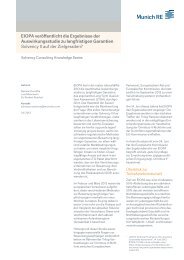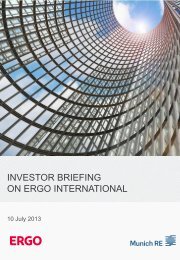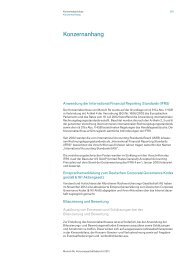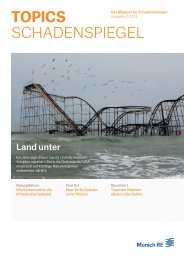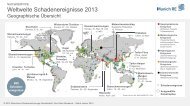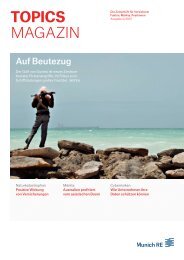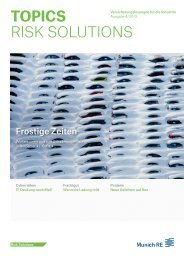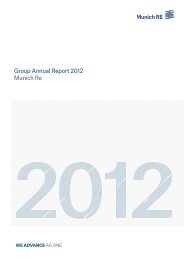Munich Re Group Annual Report 2006 (PDF, 1.8
Munich Re Group Annual Report 2006 (PDF, 1.8
Munich Re Group Annual Report 2006 (PDF, 1.8
You also want an ePaper? Increase the reach of your titles
YUMPU automatically turns print PDFs into web optimized ePapers that Google loves.
<strong>Munich</strong> <strong>Re</strong> <strong>Group</strong> <strong>Annual</strong> <strong>Re</strong>port <strong>2006</strong><br />
Combined ratios for the last ten years<br />
Insurance risk: Life and health<br />
Risk management processes<br />
In life insurance and reinsurance, biometric, lapse and<br />
interest-guarantee risks are especially relevant. The calculation<br />
of underwriting provisions is based on “biometric”<br />
actuarial assumptions, i.e. on assumptions with regard to<br />
mortality and disablement, which also take future trends<br />
into account. In primary insurance, the assumptions are<br />
determined by the requirements of the supervisory authorities<br />
or institutes of actuaries, depending on the specific<br />
national regulations, and include appropriate safety margins<br />
determined by our actuaries.<br />
In reinsurance, we calculate the biometric risk mainly<br />
on the basis of tables relating to mortality and claims<br />
development, published by national actuarial associations.<br />
These tables are modified in accordance with the experience<br />
observed in the reinsured portfolios and with the<br />
assistance of our Centre of Competence for Biosciences to<br />
reflect future trends. Lapse risks can be reduced in insurance<br />
and reinsurance by means of suitable product and<br />
contract design. We estimate the residual lapse risk by<br />
means of product-specific portfolio analyses and take this<br />
into account in our pricing.<br />
As far as the interest-guarantee risk in primary life<br />
insurance is concerned, the guaranteed actuarial interest<br />
rate applicable at the time a policy is established is used in<br />
calculating the actuarial reserve for that policy. Should<br />
capital market interest rates fall to a very low level for a<br />
prolonged period, our primary life and health insurers<br />
might not be able to earn the required guaranteed interest<br />
rate.<br />
In reinsurance, we exclude the interest-guarantee risk<br />
in many cases through suitable treaty design or by a backto-back<br />
micro hedge of the risk.<br />
Furthermore, as a matter of principle, we use marketconsistent<br />
assumptions for determining the technically<br />
risk-adequate price for each contract.<br />
134<br />
Management report_Risk report<br />
All figures in % <strong>2006</strong> 2005 2004 2003 2002 2001 2000 1999 1998 1997<br />
Including natural catastrophes 92.6 111.7 98.9 96.5 123.7 ** 136.9 * 116.2 119.7 105.2 102.0<br />
Excluding natural catastrophes 91.3 92.3 93.9 94.7 120.3 ** 135.3 * 114.1 108.0 101.2 100.7<br />
* Thereof World Trade Center and reserve strengthening at American <strong>Re</strong>: 24.3%.<br />
** Thereof World Trade Center and reserve strengthening at American <strong>Re</strong>: 17.1% .<br />
Risk exposures<br />
The notes to the consolidated financial statements include<br />
a differentiated analysis of how the parameters determining<br />
the underwriting items of the balance sheet affect the<br />
risks in life insurance and reinsurance. This presentation is<br />
in compliance with IFRS 4 accounting requirements.<br />
For our life reinsurance and primary life and health<br />
insurance business, our embedded value disclosure<br />
provides details of the sensitivity of the embedded value<br />
and the value added by new business to factors such as<br />
changes in mortality/morbidity, lapse rates, expenses,<br />
interest rates, and equity and property market value<br />
changes. The disclosure follows the Additional Guidance<br />
on European Embedded Value Disclosures as published<br />
by the CFO Forum, an organisation of the Chief Financial<br />
Officers of large insurance companies, in September 2005.<br />
As soon as the European Embedded Values for <strong>2006</strong><br />
have been calculated, they will be published on our website<br />
on 4 May 2007. Last year’s disclosure of the European<br />
Embedded Value from 9 May <strong>2006</strong>, available on our website,<br />
shows that the most significant risk for reinsurance is<br />
the risk of future mortality being less favourable than that<br />
assumed in our valuation bases. For primary insurance,<br />
the most significant risk is the risk of falls in interest rates<br />
for a prolonged period, although this risk has been significantly<br />
although not completely mitigated through the large<br />
swaption transactions entered into by the ERGO life companies<br />
during 2005 and <strong>2006</strong>.<br />
Operational risks<br />
Operational risks comprise the risks of losses as a result of<br />
inadequate processes, technical failure, human error or<br />
external events. These include criminal acts committed by<br />
employees or third parties, insider trading, infringements<br />
of antitrust law, business interruptions, inaccurate processing<br />
of transactions, non-compliance with reporting<br />
obligations or disagreements with business partners.



